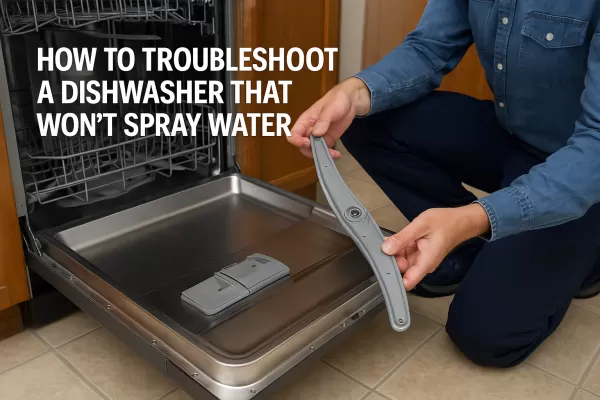May 8, 2025
How to Troubleshoot a Dishwasher That Won’t Spray Water
Is your dishwasher leaving dishes dirty, making odd noises, or pooling water at the bottom after a cycle? These are common symptoms of a dishwasher failing to spray water correctly. Diagnosing the issue can be tricky since you can’t watch it in action—but with a little guidance, you can pinpoint and fix the problem. Here’s a step-by-step guide to help you troubleshoot.
How to Know If Your Dishwasher Isn’t Spraying Water
Since dishwasher cycles happen behind closed doors, the issue isn’t always obvious. Look for these signs:
- Dirty dishes: Dishes remain soiled or only partially cleaned at the end of a wash cycle.
- Unusual quietness: If your dishwasher is quieter than usual, it could mean the spray arms aren’t operating.
- Undissolved detergent: Powder or pod detergents left behind may indicate there’s no water flow.
- Loud grinding sounds: A struggling pump may make loud noises if it’s not circulating water properly.
Step 1: Check the Spray Arms
The spray arms are responsible for distributing water across your dishes. These plastic arms rotate during the cycle, shooting water through small holes. If they’re blocked, your dishes won’t get clean. Here’s how to inspect and clean them:
- Ensure nothing is obstructing the arms. Spin both the upper and lower arms manually to confirm they rotate freely.
- Remove dish racks to gain access if needed.
- Unscrew the spray arms counterclockwise. If they won’t come off, refer to your owner’s manual.
- Run water through the spray arms and check for full flow through each hole.
- Use a toothpick or thin wire to clear any clogs in the spray holes.
- Soak the arms in warm, soapy water, rinse thoroughly, and clean internally with a pipe cleaner or small brush.
- Reinstall the spray arms and run a cycle to see if performance improves.
Step 2: Clean the Filter
A clogged filter can reduce water flow to the pump, which in turn affects the spray arms. Cleaning the filter ensures optimal water circulation.
- Remove the lower dish rack.
- Unscrew the filter—most twist counterclockwise. If it’s covered, consult your manual.
- Clear out any trapped debris.
- Rinse the filter under the faucet and scrub gently with a soft brush if needed.
- Reinstall the filter and test your dishwasher’s performance.
Step 3: Inspect the Water Inlet Valve
The water inlet valve controls the flow of water into your dishwasher. If it’s malfunctioning or blocked, the unit won’t receive the water it needs to spray.
- Turn off your home’s water supply before proceeding.
- Locate the water inlet valve—typically at the base of the machine, behind an access panel.
- Check for visible wear, cracks, or mineral buildup.
- Examine the mesh screens on the valve for clogs.
- If the valve is damaged or clogged, replace it with a part that matches your model.
- Reassemble, turn the water supply back on, and run a cycle to check if spraying resumes.
Step 4: Test the Dishwasher Pump
The pump circulates water through the spray arms. A faulty or obstructed pump—especially at the impeller—can disrupt water distribution.
- Disconnect the dishwasher from power to ensure safety.
- Remove the lower access panel to locate the pump (consult your manual for exact placement).
- Inspect the impeller—a small fan-like component—for debris such as food scraps or glass pieces.
- Clear any obstructions and manually rotate the impeller to ensure it moves freely.
- Reassemble, restore power, and run a wash cycle to confirm if normal operation returns.
With these steps, you can systematically diagnose and repair a dishwasher that isn’t spraying water. Regular cleaning and occasional part inspections can go a long way in preventing future issues.


